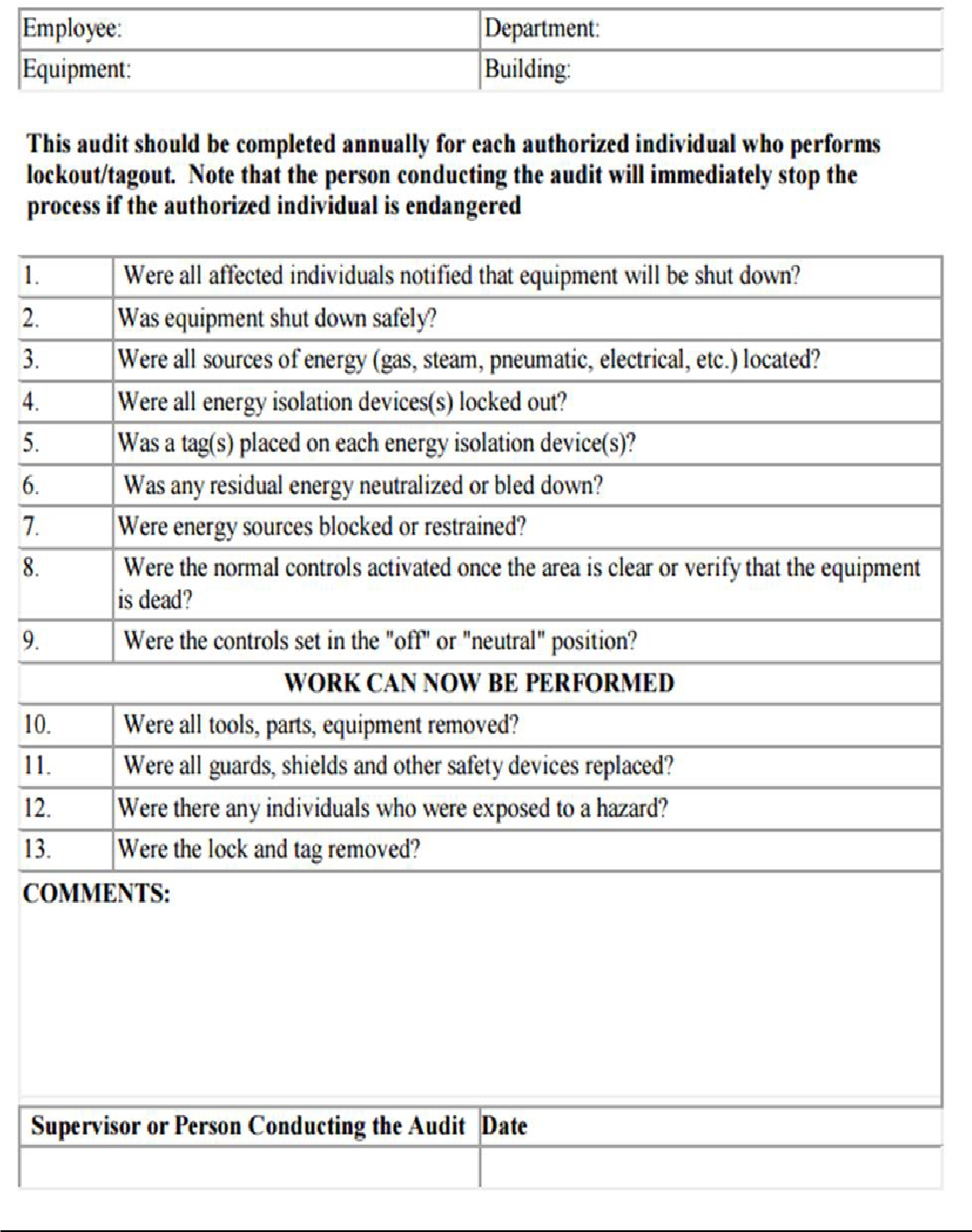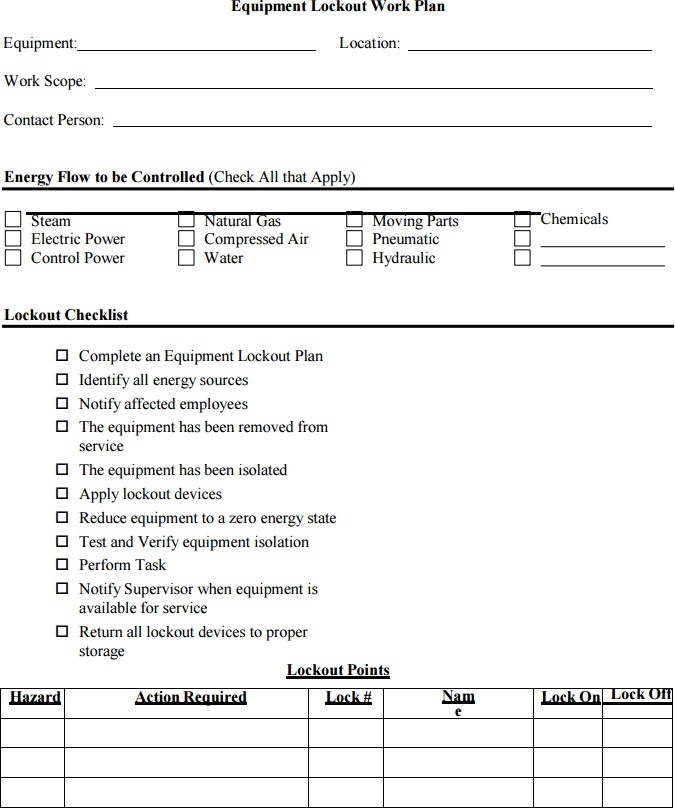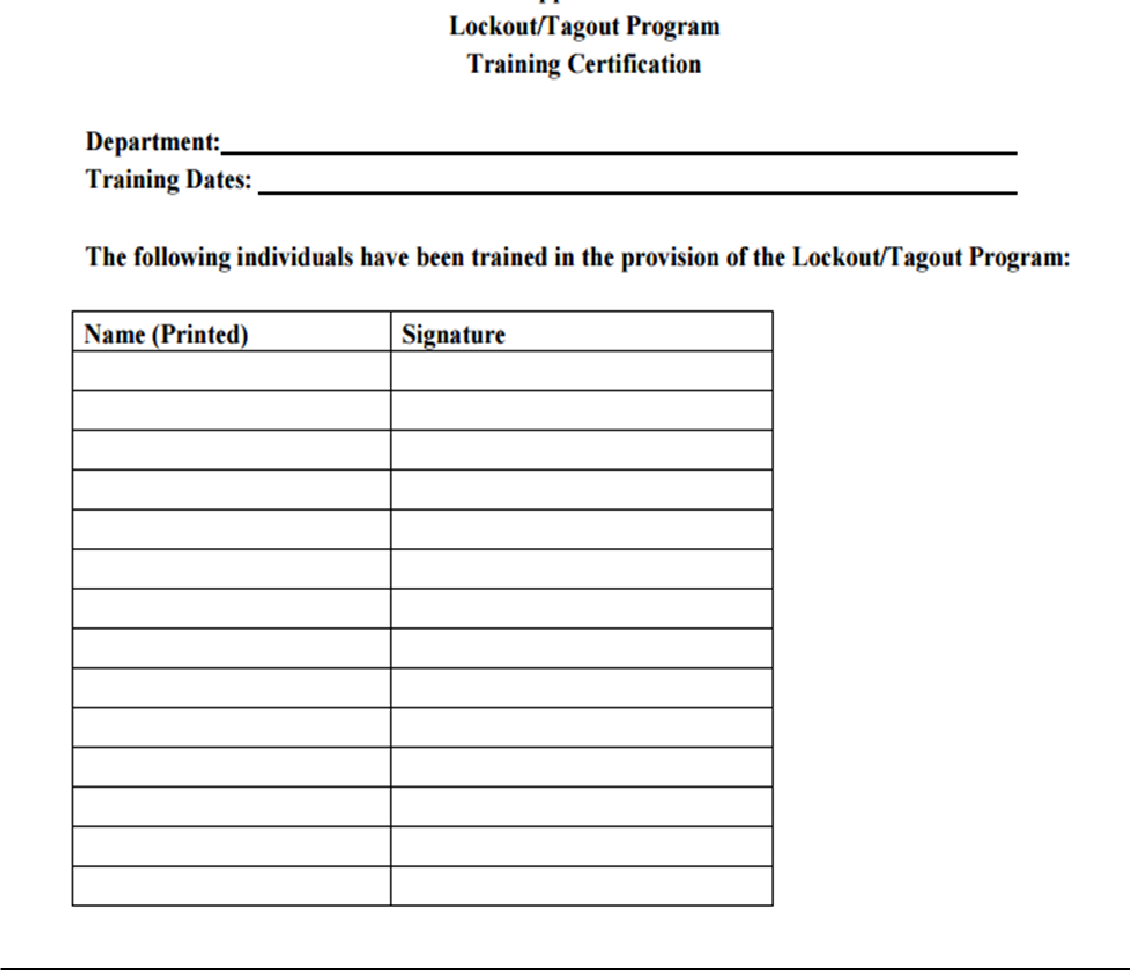Objective
It shall be the policy of the University of Tennessee to follow accepted standards and regulations to protect the health and well-being of its employees and students. The Occupational Safety and Health Administration’s (OSHA) Control of Hazardous Energy (also known as lockout/tagout) shall be implemented and followed by affected individuals.
Although the OSHA standard applies to employees, this program was written to include students and visitors to the University where feasible. Contractors are covered by this program when working with UT students or employees and while working on UTHSC-owned equipment that could impact the safety of the students or UTHSC employees.
Accidents and injuries associated with unexpected equipment start up during maintenance and repair activities can be serious. Amputations, electrocutions and fatalities can occur due to failure to follow accepted lockout/tagout procedures.
Scope
The following written plan was developed to provide general information and guidance for those departments on campus who have employees covered by the OSHA Lockout/Tagout standard (29 CFR 1910.147). This program also serves as a supplement to required training.
Departments with employees that work on UT owned equipment must have specific lockout/tagout procedures.
Roles
Campus Safety shall:
- Serve as a technical resource for questions and comments for the lockout/tagout program and periodically review compliance with this program.
- Post the most recent edition of this policy on the Campus Safety website.
- Review and revise this policy periodically and upon notice of the need for changes.
- Maintain records as required.
- Provide general training on lockout/tagout safety upon request.
Supervisors shall:
- Conduct pre-work safety briefings with supervisors, when applicable.
- Ensure that specific policies and procedures concerning lockout/tagout safety practices are in place.
- Enforce the use of lockout and tagout devices when employees do service or maintenance work and may be exposed to hazardous energy
- Notify affected employees of lockout/tag-out procedures that are going to take place in their work area.
- Develop and maintain safe shut down procedures on each piece of equipment or machine that their employees are expected to service or maintain.
- Maintain written procedures developed for equipment containing more than one energy source.
- Ensure employees have the proper lockout tagout equipment.
- Ensure that employees are properly trained on the use of lockout/tagout devices.
- Maintain training and audit records.
- Ensure authorized individuals are audited annually on lockout/tagout.
Authorized Employees shall:
- Conduct safety briefings with all personnel, prior to the start of any work.
- Participate in training on the purpose and use of energy-control procedures.
- Comply with the UTHSC lockout/tagout policy and the specific shut down procedures
- Follow the lockout/tagout procedures described in this policy and the department’s specific policy.
- Notify their supervisor when they have any questions about isolating energy sources safely; have observed on-compliance activities or when problems are identified with equipment or lockout devices.
- Perform audits on lockout tagout, but does not use lockout/tagout on the equipment that is being audited.
Affected Employees (non-authorized employees) shall:
- Participate in awareness training concerning the procedures and the prohibition against starting machines that are locked or tagged out.
Contractors and Subcontractors Shall:
- Comply with all provisions of UTHSC’s Lockout/Tagout Policy.
- Ensure that his or her employees are appropriately trained and authorized.
- Ensure that a fully qualified lockout/tagout program is in effect with the contractor/sub- contractor. The program is the responsibility of the Contractor and Subcontractors, individually. If a contractor sub-contracts to complete the work, then the Contractor is responsible for verification and compliance of the lockout/tagout program of the subcontractor.
- Comply with any shut down procedures that have been developed by the University for each Machine or piece of equipment that the contractor must service or maintain or other such project where energy sources are present. When shut down procedures are not available from the University, the contractor shall develop and provide the University with their own shut down procedures for that machine or piece of equipment or project.
- Provide certifications of training when applicable, and requested.
- Ensure that a safety briefing has been completed prior to any work, with all personnel involved including applicable University staff.
Abbreviations, Acronyms and Definitions:
Affected employee: A person who uses equipment that is being serviced under lockout or tagout procedures, or who works in an area where equipment is being serviced.
Authorized employee: A person who locks out or tags out equipment to do service or maintenance work. An affected employee becomes an authorized employee when that employee’s duties include service or maintenance work on equipment.
Capable of being locked out: An energy-isolating device that is designed with a hasp or other means of attachment to which, or through which a lock can be affixed, or if it has a locking mechanism built into it. Other energy-isolating devices will also be considered to be capable of being locked out, if lock out can be achieved without the need to dismantle, rebuild, or replace the energy- isolating device or permanently alter its energy-control capability.
Disconnect: A switch that disconnects an electrical circuit or load (motor, transformer, or panel) from the conductors that supply power to it. An open circuit does not allow electrical current to flow. Under a lockout procedure, a disconnect must be capable of being locked in the open position.
Energized: Connected to an energy source or containing potential energy.
Energy source: Any source of energy. Examples: electrical, kinetic, potential, mechanical, hydraulic, pneumatic, chemical, and thermal.
Energy-isolating device (EID): A mechanical device that physically prevents transmission or release of energy.
Hazardous energy: Any of the types of energy existing at a level or quantity that could be harmful to workers or cause injury through inadvertent release or start-up of equipment. Lockout device: A device that locks an energy-isolating device in the safe position.
Lockout: Placing a lockout device on an energy-isolating device, under an established procedure, to ensure the energy-isolating device and the equipment it controls can’t be operated until the
lockout device is removed. (An energy-isolating device is capable of being locked out if it has a hasp that accepts a lock or if it has a locking mechanism built into it.)
Procedure: A series of steps taken to isolate energy and shut down equipment.
Servicing or maintenance: Workplace activities such as constructing, installing, setting up, adjusting, inspecting, modifying, and maintaining machines or equipment. Also includes lubricating, cleaning, unjamming, and making adjustments or tool changes if a worker may be exposed to the unexpected startup of the equipment during such activities.
Procedure
- General Safety Requirements
- A specific procedure must be developed for equipment containing more than one energy source.
- Each department is encouraged to develop these written procedures. A copy of the procedure should be kept in the department’s file and ideally a copy posted at the equipment.
- The Lockout/Tagout Procedure (Appendix A) provides a template for procedure development.
- Campus Safety is available to assist in the development of written procedures.
- Procedures shall clearly outline the scope, purpose, authorization, rules and techniques to be used for each energy source.
- If an error or omission is detected in a specific written procedure, it is the responsibility of the authorized individual who identifies the error or omission to bring it to the attention of his or her supervisor.
- Corrections must then be made and communicated to each authorized individual who works with this procedure.
Hot Tap Work
Hot taps involve working on equipment while it is energized. Hot tap work is discouraged and should only be done where it is infeasible to do otherwise and must be done by knowledgeable authorized individuals.
Where hot tap work is conducted, additional precautions must be taken and specific written procedures must be developed. Authorized individuals performing hot tap work must be trained in these procedures.
Signs and Warnings
Signs must be placed on all equipment requiring lockout/tagout at the energy isolation device.
Lockout and tagout devices:
Lockout and tagout devices must meet the following criteria to ensure that they are effective and not removed inadvertently:
- Lockout devices must work under the environmental conditions in which they are used. Locks shall only be used for lockout purposed and shall be “heavy-duty”. Heavy-duty is defined as a lock that can be removed only with heavy-duty bolt cutters
- Tagout device warnings must remain legible even when they are used in wet, damp, or corrosive conditions. Tags shall be held in place with a tie capable of withstanding 50 lbs. of force. At least one tag must be provided for locations where locks are applied. Note that if more than one energy isolation device (EID) is locked out, there must be a tag at each EID.
- Lockout and Tagout devices must be designated by color, shape, or size. The locks and tags used for lockout shall be standardized within each department. An authorized individual should never lend their lock or key to anyone else. Tagout devices must have a standardized print and warning format.
- Lockout devices and Tagout devices must be strong enough that they can’t be removed inadvertently. Tagout devices must be attached with a single-use, self- locking material such as a nylon cable tie.
- Procedure in which multiple individuals have applied their locks (e.g. staff members working on different shifts or on different portions of a project.) In such situation each individual must apply their lock so that the equipment will not be operable until each individual involved in the project has completed their work and removed their lock.
- Any employee who sees a lockout or Tagout device must be able to recognize who attached it and its purpose.
- Each lock must have a unique key or combination. An authorized individual should never lend their lock or key to anyone else. There may be situations where several locks are necessary for a lockout. A department may elect to have several locks that can be used as a unit. However, control must be maintained over the keys.
NOTE: Local procedures shall address situations in which multiple individuals have applied their locks (e.g. staff members working on different shifts or on different portions of a project.) In such situation each individual must apply their lock so that the equipment will not be operable until each individual involved in the project has completed their work and removed their lock.
- Energy-isolating devices are the primary means for protecting UTHSC employees who service equipment and must be designed to accept a lockout device. Energy isolating devices must clearly identify function.
Electrical energy sources
Lockout or tagout of electrical energy sources must occur at the circuit disconnect switch. Electrical control circuitry does not effectively isolate hazardous energy. See also, Alternative methods.
Lock Removal
Locks and/or tags must not be removed by anyone other than the authorized individual who installed it. There is one exception to this rule. The authorized individual’s supervisor may remove his or her lock, but only when it is absolutely necessary to remove the lockout/tagout. If the lock and/or tag are removed, every effort must be made to notify the authorized individual that his or her lock has been removed. Efforts to be made to notify the authorized individual that their lock has been removed include:
- Verification that the authorized employee who applied the device is not on site;
- Making all reasonable efforts to contact the authorized employee to inform him/her that his/her lockout or tagout device has been removed;
- Ensuring that the authorized employee has this knowledge before he/she resumes work on the site.
Equipment for lockout/tagout
The following is a list of equipment that may be used in lockout. An adequate supply of each required item must be available for the authorized individual.
- Lock and key
- Tags and ties
- Multiple lock hasp
- Lock box (if used in the department)
- Breaker locks
- Fuse pullers
- Insulated mats
- Hot sticks
- Chains
- Electrical meter to determine the status of an electric circuit
- Valve covers
- Blocks
- Blanks
- Jacks
- Supports (posts, columns, timbers, etc.)
- Other items as necessary
Lockout/Tagout Auditing
The OSHA standard requires that each authorized employee be audited annually on lockout/tagout. The audit must be conducted by an authorized individual who is authorized to perform a lockout/tagout, but does not use lockout/tagout on the equipment that is being audited. To assist departments in auditing, an audit checklist has been developed (see Appendix B). This form, or a similar record, should be maintained in the department’s files.
Off-Site Safety
Each department head is responsible for identifying lockout/tagout activities affecting their employees and students while engaged in University-sponsored activities away from the main campus. Provisions shall be made to assure that these individuals are not exposed to hazards posed by activities requiring lockout/tagout.
Exposure survey
Authorized Individuals will conduct a hazardous-energy survey to determine affected machines and equipment, types and magnitude of energy, and necessary service and maintenance tasks. Each task will be evaluated to determine if it must be accomplished with lockout or tagout procedures.
Energy control procedures
- Authorized employees who lockout or tagout equipment or do service and maintenance must follow specific written energy-control procedures. The procedures must include the following information:
- The intended use of the procedure
- Steps for shutting down, isolating, blocking, and securing equipment
- Steps for placing, removing, and transferring lockout devices
- Equipment-testing requirements to verify the effectiveness of the energy-control procedures
These procedures are required when re-energizing equipment is necessary and when power is needed to test or position the equipment (for example, temporary removal of lockout or tagout devices is allowed. This applies only for the time required to perform the task and the procedure must be documented.
Employees must do the following before they begin service or maintenance work:
- Inform all affected employees of equipment shutdown.
- Shut down equipment.
- Isolate or block hazardous energy
- Remove any potential (stored) energy.
- Lockout or tagout the energy sources.
- Verify the equipment is isolated from hazardous energy and de-energized.
Employees must complete following for removing lockout or tagout devices and re- energize equipment:
- Remove tools and replace machine or equipment components.
- Inform coworkers about energy-control device removal.
- Ensure all workers are clear of the work area.
- Verify machine or equipment power controls are off or in a neutral position.
- Remove the lockout or tagout device.
- Re-energize equipment
Specific energy-control procedures
Departments shall have developed specific energy-isolation procedures for all machines and equipment that have energy-isolating devices
Energized testing:
When an energy-isolating device is locked or tagged and it is necessary to test or position equipment, do the following:
- Remove unnecessary tools and materials.
- Ensure that all other employees are out of the area.
- Remove locks or tags from energy isolating devices.
- Proceed with test.
- De-energize equipment and lockout or tagout energy-isolating devices.
- Operate equipment controls to verify that the equipment is de-energized.
Contract service and maintenance
The OSHA standard requires that contractors be made aware of specific lockout/tagout procedures. Note: this applies to “specific” procedures and not the general procedure found in Appendix A.
Both UTHSC employees and contractors must be aware of their respective lockout/tagout procedures before the contractor does onsite work. UT employees must understand and comply with the contractor’s energy control procedures.
Group lockout
When authorized employees must service equipment that has several energy sources and several energy-isolating devices, the employees must follow specific group lockout procedures.
Shift Changes and Long-Term Shutdowns
Employees must follow the department’s specific written procedures when it is necessary to
continue lockout/tagout when work shifts change and during long-term shutdowns. Supervisors are responsible for monitoring lockout and tagout devices that control the energy to equipment during long-term shutdowns
Alternative methods
- When lockout or tagout is not used for tasks that are routine, repetitive, and integral to the production process, or prohibits the completion of those tasks, then an alternative method must be used to control hazardous energy
- Selection of an alternative control method must be based on a risk assessment of the machine, equipment, or process. The risk assessment must consider existing safeguards provided with the machine, equipment or process that may need to be removed or modified to perform a given task. For example, when control circuits are used as part of the safeguarding system, the system must be designed to ensure protection as effective as a mechanical disconnect switch or master shut-off valve. A control-reliable dual channel hardwired circuit of industrially-rated components that satisfies the design features as specified in ANSI B11.19, with a safety relay or safety PLC to ensure integrity and performance of the safeguarding system, must be used.
- Under all circumstances, the individual must have exclusive personal control over the means to maintain the state of the control circuit in a protective mode.
Inspections Of Written Energy-Control Procedures
Authorized Employees or Supervisors will perform and document annual inspections of energy control procedures to ensure that employees understand and use them effectively. Documentation will include the following:
- The equipment on which the procedure is used.
- The date of the inspection.
- The employees included in the inspection.
- The inspector.
If an inspector finds that employees are not following an energy-control procedure or that the procedure is not protecting them, employees must be retrained and the procedure’s deficiencies corrected. The inspector must understand the procedure and must be someone other than those following the procedure at the time of the inspection. Each procedure’s accuracy, completeness, and effectiveness must be verified.
If the inspection covers a procedure for equipment with an energy-isolating device that can be locked out, the inspector must review the procedure with the employees who use it to service the equipment. The inspector can review the procedure with the employees individually or in a group.
If the inspection covers a procedure for equipment with an energy-isolating device that can only be tagged out, the inspector must review the procedure with the authorized employees who service the equipment and with affected employees who may work in the area when the equipment is serviced. The inspector can review the procedure with the employees individually or in a group. See Appendix B for a sample Annual Employee Audit form.
Training:
Employees who may be exposed to hazardous energy will receive training before assignment to ensure that they understand UT’s energy-control policy and the department specific policy, and have skills to apply, use, and remove energy controls. The training will include the requirements of 29 CFR 1910.147 and the following:
- Affected employees will be trained in the purpose and use of energy-control procedures. An affected employee uses equipment that is being serviced under lockout or tagout procedures or works in an area where equipment is being serviced.
- Authorized employees will be trained to recognize hazardous energy sources, the type and magnitude of energy in the workplace, the methods and means necessary for isolating and controlling energy, and the means to verify that the energy is controlled. An authorized employee locks out or tags out equipment to do service work. An affected employee becomes an authorized employee when that employee’s duties include service or maintenance work on equipment.
- Employees whose jobs are in areas where energy-control procedures are used will be trained about the procedures and the prohibition against starting machines that are locked or tagged out.
- Employees will be retrained annually to ensure they understand energy-control policy and procedures.
- Authorized and affected employees will be retrained whenever their job assignments change, energy-control procedures change, equipment or work processes present new hazards, or when they don’t follow energy-control procedures.
Current training records will be maintained for each authorized and affected employee including the employee’s name and the training date. A sample form documenting training certification is found in Appendix C. Authorized individuals shall be trained in lockout/tagout procedures.
Training shall be provided to the following individuals:
- New employees;
- Employees who have transferred into the department;
- Employees who demonstrate a lack of knowledge in the lockout/tagout procedure;
- When new equipment is introduced, or when a specific procedure is developed or modified; and
- Periodic refresher – recommended annually
Recordkeeping
Training must be documented. Each department must maintain a record of the training. The following information should be contained in the training record:
- date of training,
- instructor, name of employee and location and a brief description or outline of what was covered.
NOTE: Provisions shall be made for individuals who have limited reading skills to ensure they are familiar with the necessary information.
A test is suggested at the end of each training program to demonstrate that the participants have the requisite knowledge.
Responsible Official & Additional Contacts
|
Subject Matter |
Office Name |
Telephone Number (xxx) xxx-xxxx |
Email/Web Address |
|
Policy Clarification and Interpretation |
Campus Safety and Emergency Management |
901-448-6114 | |
|
Policy Training |
Campus Safety and Emergency Management |
901-448-6114 |
Related Policies/Guidance Documents
- SA0100 – Safety and Environmental Health Program
- SA0700 – Safety and Environmental Health Responsibilities
- GS5113 – Electrical Safety Program
Forms and Attachments:
- Generic Procedure for Lockout/Tagout (Appendix A)
- Lockout/tagout checklist – Annual Employee Audit (Appendix B)
- Equipment Lockout Work Plan (Appendix C)
- Lockout/Tagout Program Training Certification (Appendix D)
Associated Standards:
- OSHA 29 CFR 1910.147
Appendix A
Generic Procedure for Lockout/Tagout
- Identify all energy sources (e.g. electrical, steam, hydraulic, etc.) and their magnitude (e.g. 120 volts, 60 psi steam, etc.). Look for hidden energy sources such as springs, capacitors, elevated parts, etc. The equipment may contain more than one type of energy
- Notify individuals who use the equipment that it will be taken out of service.
- Stop the equipment by its normal shut down procedure.
- Isolate the equipment from its energy source. This typically involves closing valves, opening switches or operating other energy isolation devices. Note – an on/off switch or run/stop switch are not energy isolation devices.
- Dissipate or secure stored energy. This may involve repositioning, blocking, bleeding, braking, etc.
- Apply your lock to the energy isolation device.
- Always provide a completed tag with your lock.
- A tag alone can only be used where it is infeasible to lockout an energy source . Additional precautions must be followed if only a tag is used.
- Each individual working on the equipment must install their lock. It may be necessary to use a multiple lock hasp.
- Ensure that no one is exposed to danger, and then as a check to be sure that all energy sources are isolated, activate the equipment’s normal controls to make certain the equipment will not operate. Check to make sure you any test equipment (e.g. multi- meter) is working as designed.
CAUTION: Always return the controls to the “neutral” or “off” position after this test. Only when the equipment is locked and/or tagged out may work proceed.
Temporary Removal of Lockout for Testing or Adjustments
- Clear equipment of tools, etc.
- Remove employees from danger zone
- Remove lock and/or tag
- Proceed with test by energizing the equipment
- De-energize equipment (following steps three through seven above)
Restoring the Equipment After Work is Completed
- Check the area around the equipment to insure that no one is exposed to danger after servicing or maintenance is complete
- Remove all tools, loose parts, etc. from the equipment
- Replace all guards, shields or other safety features
- Remove the tag and lockout devices. Each person must remove their own lock
- Operate the energy isolation device to restore energy to the equipment
Shift Changes and Prolonged Lockout/Tagout
When a shift change is occurring and the out-going shift will be removing their lockout/tagout and the incoming shift will be applying their lockout/tagout, at least one employee from each shift must be present at the equipment for the change.
The incoming shift shall apply their lockout/tagout before the outgoing shift leaves. It is acceptable to maintain a lockout continuously for an indefinite period of time.
Questions regarding the lockout/tagout policy should be addressed to Campus Safety at 448- 1334.
Appendix B LOCKOUT/TAGOUT CHECKLIST
Annual Employee Audit

Appendix C LOCKOUT/TAGOUT PROGRAM
Equipment Lockout Work Plan

Appendix D LOCKOUT/TAGOUT PROGRAM
Training Certification







